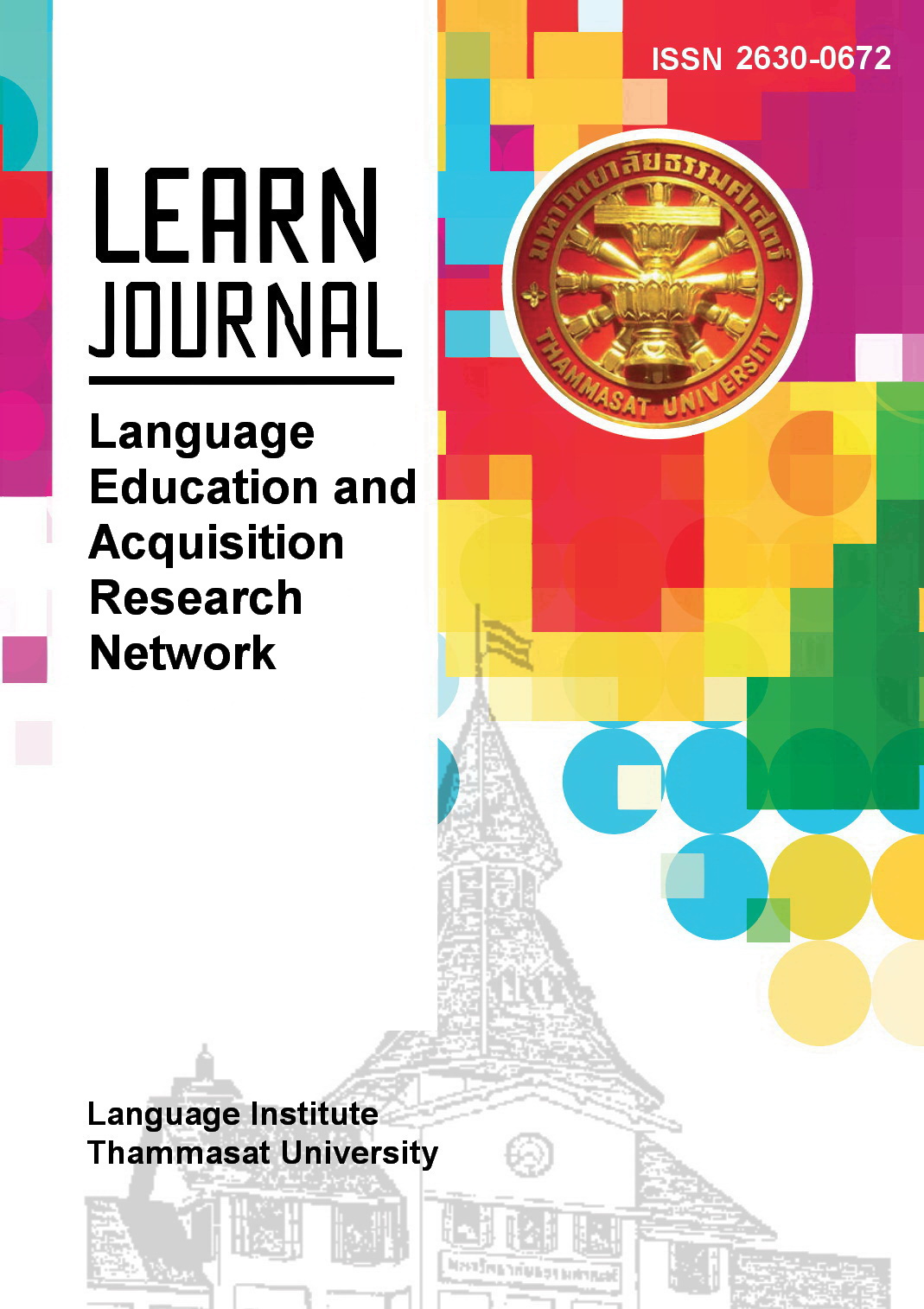Thai EFL Learners’ Use and Perceptions of Mobile Technologies for Writing
Main Article Content
Abstract
Despite the fact that technologies are commonly implemented in language classrooms and widely incorporated by students in their language learning, research on English learners’ actual practices of technologies, especially the use outside the classroom, has been mostly limited. The aim of this study was to explore undergraduate English language learners’ independent use and perceptions of mobile technologies for their foreign language writing, a productive skill that requires linguistic expertise in various aspects. Data were collected through a questionnaire from 305 English learners who enrolled in various English for Specific Purpose courses in a public university in Thailand. The findings indicated that the participants used various mobile technologies that mainly concerned with linguistic aspects of writing such as online dictionaries, machine translations, and language checker applications to support their foreign language writing. Their primary purposes of using technologies were to achieve accuracy, confidence and efficiency in their writing. This study sheds light on how mobile technologies play a supportive role and offer pedagogical potential in language learners’ lives beyond the borders of classrooms.
Article Details
References
Al-Shehab, M. (2020). The role of Mobile-assisted Language Learning (MALL) in enhancing the writing skills of intermediate IEP students: Expectations vs reality. Language Teaching Research Quarterly, 20, 1-18.
Al-Wasy, B.Q., & Mahdi, H. S. (2016). The effect of mobile phone applications on improving EFL learners’ self-editing. Journal of Education and Human Development, 5(3), 149-157.
Awada, G. (2016). Effect of WhatsApp on critique writing proficiency and perceptions toward learning. Cogent Education, 3,
https://doi.org/10.1080/2331186X.2016.1264173.
Chuenchaichon, Y. (2015). A review of EFL writing research studies in Thailand in the past 10 years. Journal of Humanities, Naresuan University, 11(1), 13-20.
Giannetti, T. R. (2016). Google translate as a resource for writing: A study of error production in seventh grade Spanish [Master’s thesis, St. John Fisher College].
https://fisherpub.sjfc.edu/cgi/viewcontent.cgi?article=1358&context=education_ETD_masters
Gibson, W. J., & Brown, A. (2009). Working with qualitative data. Sage.
Han, S., & Shin, J. A. (2017). Teaching Google search techniques in an L2 academic writing context. Language Learning & Technology, 21(3), 172-194.
Kacetl, J., & Klímová, B. (2019). Use of smartphone applications in English language learning-A challenge for foreign language education. Education Sciences, 9(3), 179.
Kukulska-Hulme, A. (2009). Will mobile learning change language learning? ReCALL, 21(2), 157-165.
Kukulska-Hulme, A. (2010). Learning cultures on the move: Where are we heading? Educational Technology & Society, 13(4), 4-14.
Kukulska-Hulme, A., & Shield, L. (2008). An overview of mobile assisted language learning: From content delivery to supported collaboration and interaction. ReCALL, 20(3), 249-252. http://dx.doi.org/10.1017/S095834400800013X.
Lantolf, J. P. (2000). Second language learning as a mediated process. Language teaching, 33(2), 79-96.
Lee, C. (2020). A study of adolescent English learners’ cognitive engagement in writing while using an automated content feedback system. Computer Assisted Language Learning, 33(1–2), 26–57. https://doi. org/10.1080/09588221.2018.1544152.
Lee, K. J., & Kim, J. E. (2013). A mobile-based learning tool to improve writing skills of EFL learners. Procedia-Social and Behavioral Sciences, 106, 112-119.
Lee, M. (2019) The impact of using machine translation on EFL students’ writing. Computer Assisted Language Learning, 33(2), 1-19. https://doi.org/10.1080/09588221.2018.1553186
Niño, A. (2020). Exploring the use of online machine translation for independent language learning. Research in Learning Technology, 28. https://doi.org/10.25304/rlt.v28.2402
Peng, H., Su, Y.-J, Chou, C. & Tsai, C.-C. (2009). Ubiquitous knowledge construction: Mobile learning re-defined and a conceptual framework. Innovations in Education & Teaching International, 46, 171-183. https://doi.org/10.1080/14703290902843828
Pongkasamepongon, P. (2018). L2 Writing processes of Thai graduate students [Master’s thesis, National Institute of Development Administration]. NIDA Wisdom Repository.
https://repository.nida.ac.th/handle/662723737/4523
Purcell, K., Buchanan, J. & Friedrich, L. (2013). The impact of digital tools on student writing and how writing is taught in schools. Pew Research Center.
Richards, J. C., & Renandya, W. A. (2002). Methodology in language teaching: An anthology of current practice. Cambridge University Press.
Sharples, M., Taylor, J., & Vavoula, G. (2007). A theory of learning for the mobile age. In R. Andrews & C. Haythornthwaite (Eds.), The Sage handbook of E- learning research (pp.221-247). Sage.
Shi, L. (2012). Rewriting and paraphrasing source texts in second language writing. Journal of Second Language Writing, 21(2), 134-148.
Stapleton, P. (2002). Critiquing voice as a viable pedagogical tool in L2 writing: Returning the spotlight to ideas. Journal of Second Language Writing, 11, 177-190.
Steel, C.-H., & Levy, M. (2013). Language students and their technologies: Charting the evolution 2006-2011. ReCALL, 25(3), 306-320. https://doi.org/10.1017/S0958344013000128
Tsai, S. C. (2020). Chinese students’ perceptions of using Google Translate as a translingual CALL tool in EFL writing. Computer Assisted Language Learning.
https://doi.org/10.1080/09588221.2020.1799412
Umamah, A., & Cahyono, B. Y. (2022). EFL university students’ use of online resources to facilitate self-regulated writing. Computer Assisted Language Learning Electronic Journal (CALL-EJ), 23(1), 108-124.
Vygotsky, L. S. (1978). Mind in society: The development of higher psychological processes. Harvard University Press.
Zhang, R., & Zou, D. (2021). Types, features, and effectiveness of technologies in collaborative writing for second language learning. Computer Assisted Language Learning, 1-31. https://doi.org/10.1080/09588221.2021.1880441


